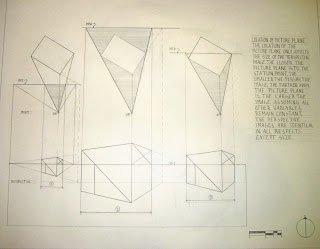Audience: An audience is a group of people who are watching an event. It could also mean “the act of hearing, or attending to, words or sounds.” (dictionary.com) When you are going to a play, there is always a big audience to watch the performance. For some people, their motivation comes from knowing that others will be watching them at some point. In studio, we make projects that eventually get critiqued by the audience of everyone in the class and teachers.

[Re]visions: Revising is the process of making a new version of the original. In drafting, we always make our first drawing on bond paper and then the finalized one is on vellum. We revise the bond drawing to make it fit in the right place on the vellum so that it is in the perfect spot. The place Vendome is similar to the Place de Vosges because the outside facades are very similar in looks, but the insides are revised completely differently. (Roth)
My drafting for Stoel this week was first on bond paper and then revised onto vellum.

Character: Character is something that everything and everyone has. It is the features and traits that make up character, which makes something or someone so unique. It is important to capture a client’s character, so that when you are designing for them you can add their own character in the designs you make for them. Therefore, they will love what you have designed rather than something that does not have any of their taste in it. The saltworks building has columns in the front that have much character in them because the columns are individual blocks that stack up on top of one another. Details are what make character so unique. “Designers searched for ornamental details that were more imaginative, gay, animated, and entertaining…” (Blakemore, 246)

Transition: Transition is another word for change. It means that something transforms from one thing to another or from one idea/concept to another. In studio we form ideas/concepts that eventually change over a short period of time when doing a project. We go from one idea to the next developing our concept further and deeper. “The Regence style of chair was a transition from the primarily rectilinear forms of Louis XIV to the curvilinear contours of Louis XV.” (Blakemore, 256) The statue of David by Michelangelo is different from the statue of David by Bernini in the way that Bernini transitioned from Michelangelo’s still stance of David to an ‘in-motion’ David.


Datum: Datum can mean many things, but the one that relates to architecture is that datum is an item of information that comes from research or measurement. Basically it is a single piece of information. My furniture drawings I did for Suzanne is a piece of datum because they are assumed that they are for a family room because I drew all pieces that you would find in a family room. A circle in the Renaissance time was used as datum and “…was an especially attractive form for Renaissance designers, symbolizing the perfection of God.” (Roth, 360)
This presentation board my group made follows a set of datum because it has much information.

Summary: This weeks words are all about communication and how that communication is passed and received. A piece of datum has character that gets revised by people to transition to another idea. The audience receives the message and responds to it. Communication involves grammar and syntax when writing or speaking.
No comments:
Post a Comment